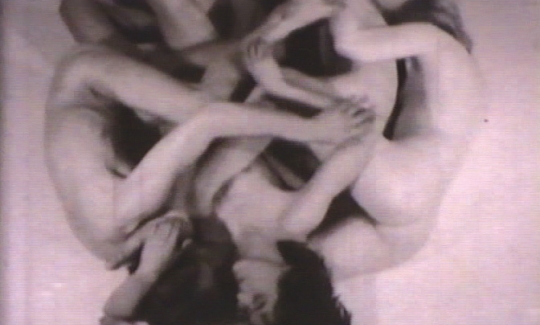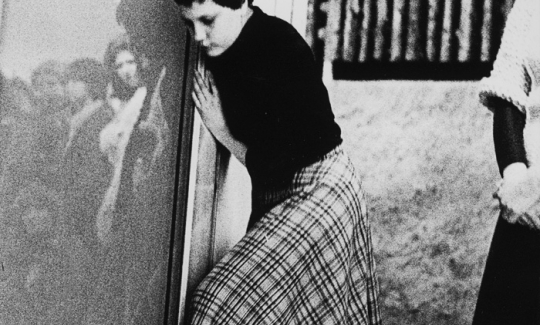Chapter 3 in the Series "Videostroia": The First Generation of projected Images
June 24, 2006 - October 29, 2006
Curator: Ilana Tenenbaum
The third chapter in the "Videostoria" series of exhibitions concludes the process of mapping the emergence of video art in the 1960s and 1970s. The previous two exhibitions examined the development of video works in relation to television and mass media, and to avant-guard cinema. "Performing the Body" ends the series with an investigation of the connections between the inception of video art, performance art and conceptual actions.
This exhibition includes both international and Israeli artists; it focuses on the ways in which the artist's body became both the material basis and the conduit for a powerful encounter, and makes visible the ways in which social norms are inscribed upon the individual body. Some of these works examine extreme bodily states involving the limits of physical endurance and self-mutilation, sexual urges the transgression of social taboos, critical protest, and intentionally embarrassing and uncomfortable situations. Various psychological states are at the core of many of the works, which in some instances involve reciprocal relations with the viewers. At the same time, numerous works are preoccupied with formal elements, with the deconstruction of sculptural or painterly gestures, and with conceptual actions that examine the representational limits and characteristics of the medium.
Performance art and video art, which came into being during the same period, share a wide range of characteristics - most notably their temporal dimension and their privileging of processes or occurrences over fixed definitions of the artistic object. These modes of expression make evident a critical, doubtful attitude towards their represented content. They bespeak a fragile, bifurcated sense of self, traumatic situations, a redefinition of sexual and gender identity and an attempt to overturn the accepted distinction between "artist" and "viewer." The artists who engaged with video, like those who engaged with performance, explored these issues by means of powerful psychological and dramatic effects.
In addition to examining international works, this exhibition sets out to probe the unique, local characteristics of Israeli video art during the 1970s. The performances and sets of actions that appear in documentary photographs or in works created for the camera delineate a significant set of artistic strategies for coping with a changing reality and formulating radical change through various actions, processes and interventions. These strategies were based upon international avant-guard influences, which increasingly permeated the local arena.
The works of Israeli artists touch upon the complex socio-political issues that characterized the period between the Six Day War and the Yom Kippur War and its aftermath. The collective shock and the cultural shift that took place in Israel at that time redefined the private sphere, and directly influenced the ways in which artists used their unmediated physical presence to transmit certain themes and ideas. Oftentimes, their use of the body alluded to Jewish symbols, which were reframed in new contexts. This preoccupation amounted to an involvement with the "ghosts" of Jewish culture and with their manifestation in secular, Israeli culture. It involved the probing of a complex and confused identity, whose catastrophic components were being stripped bare for examination. The act of collecting old celluloid and video films, which point to the transformation of Israeli culture through the representation of the body and of bodily actions, is intended - as in previous exhibitions - to gather and preserve these films and to allow for a reassessment of their value.
The Presence of the Body:
Psychological States as the Essence of the Work
Many video performances are predicated upon the artist's persona, physical presence, behavior and state of consciousness. These works produce psychological states that are often related to the arousal of desire or anxiety, to seduction, alienation or estrangement. Some of these works examine the possibility of communicating with the audience, with an emphasis on embarrassing and uncomfortable situations. In certain instances they express a traumatic reality, which alludes to the possibility of healing or catharsis. This concern is given expression in Vito Acconci's worksSeed Bed (1971), Claim Excerpts (1971) and Centers (1971); inMarina Abramovic and Ulay's Imponderabilia (1977); in Gilbert and George's The Singing Sculpture (1992); in Haim Maor's Circles(1975), The Blindness Films (1978) and Blind in Blue (1978); inMichael Druks' Intend to the East (1977); in Motti Mizrachi's Via Dolorosa (1973); and in Dov Or-Ner's The Last Supper (1979).
Pain, Shock and Healing
A number of the works included in this exhibition give expression to a physical presence that bespeaks the restless, largely post-traumatic spirit that shaped the 1960s and 1970s. This spirit, which was largely influenced by the aftermath of the Second World War, tended to emphasize expressions of physical shock, pain and endurance; at the same time, it also addressed messages of healing and mental and spiritual transformation that take place through the act of artistic creation. These forms of expression, which were often inspired by ritual and ceremonial elements, were often related to declarations concerning the establishment of a new social and political order; in this sense, the spiritual and ritual act often served as a means of criticizing the existing social and political order equal to direct political criticism. The use of Dionysian rituals to undermine the oppressive power of a conservative capitalist culture was an important component of this process of catharsis and rejuvenation. These themes are given expression in the exhibition in Kurt Kren's,Self-Mutilation/ Günter Brus (1965) and Oh Tannenbaum(1964); in Chris Burden's Shoot (1971); and in Joseph Beuys'Coyote: I Like America and America Likes Me (1974).
The Body's Twilight Zone: Embarrassment, Trauma
and Taboo
Many of the Israeli works included in the exhibition partake of a prominent trend aimed at marking a new set of relations between the viewer and the artist, whose actions set out to address an emotionally charged and challenging stance. These actions, which were designed to provoke states of discomfort, embarrassment, disgust or a voyeuristic urge, often give expression to a traumatic reality of pain. In contrast to key international works related to destruction, violence and cathartic liberation, the works of the Israeli artists are concerned with more subtle forms of expression. At the same time, these works are characterize by a density of themes, which are often examined with a sober and deeply doubtful gaze. This is the case in Motti Mizrachi's Healing (1980) and Cohanim Blessing (1973); Gideon Gechtman's Exposure (1975); and Dov
Or-Ner's Pharavizia (1980).
Body, Underlying Qualities, Medium and Exhibition Space
Several works in this exhibition involve a range of conceptual actions and gestures meant to elaborate on the meaning of the body's physical presence, its relation to space, or the symbolic value of the action in question. In most cases, these actions are characterized by a restricted inventory of expressive means, or by the delineation of basic graphic forms. This is the case in the Fluxus group's Flux Concert (1979); Nam June Paik'sRare Performance Documents(1961-1994); Richard Serra's Hands Scraping (1968); Gordon
Matta-Clark's Clockshower (1973); Gary Hill's Selected Works III(1978-1979); Dan Graham's Performer/Audience/Mirror (1975);Micha Ullman's Place (1975); Buky Schwartz's Videoconstructions(1978-1980); Michael Druks' Everybody's Own Square (1975); andAdina Bar-On's Performance at the Exhibition (1976), Birds, (1973) and First Performance (1973).
In the work 12.5.1975 (1975), Yair Garbuz gives expression to the collage-like aspect of conceptual art; the preoccupation with the collection of ideas, notes and lists is centered upon Garbuz's performative persona, which serves as a prism for the examination of a mixture of cultural discourses.
The Body, Materiality and Formal Structures
In Dov Or-Ner's Shoval Project (1975); Tamar Getter's Roof (1974-1975); Moshe Gershuni's Crawling (1970); and Bruce Nauman'sBouncing in the Corner, No. 1 (1968), the body circumscribes a specific territory. In some cases, this territory is the one in which the action takes place; in other instances, it is constituted by the formal relations between the body and the frame of the screen upon which the image is projected. These acts of circumscription are connected to different spheres of life - sensory-physical experiences, one's sense of self and socio-political reality.
The group of works including Efrat Natan's Milk (1974); Avraham Eilat's Chance (1971); Michal Na'aman's Glue and Honey (1975); andMotti Mizrahi's Clay (1973) bespeaks a preoccupation with simple and basic materials, which in most cases constitute an extension of the body. These materials - such as dough, milk, honey and glue - are examined as they undergo a continual process of change. The reduced material elements may be associated with certain psychological conditions and states of consciousness, or may hint at symbolic contents charged with social and political associations.
Joshua Neustein's Erasures (1971-1973); Tamar Geter's Golem(1974-1975); Michael Druks' Punishments (1973); and Paul MacCarthy's Black-and-White Tapes (1970-1975) are concerned with actions involving drawing, writing, or the application of paint - actins that are often charged with a morbid significance, which is related to entrapment in borderline situations.
Feminism and Gender: Defining the Medium
During the 1960s and 1970s, feminist performances played a central part in the development of video art and of the provocative forms of expression that characterize this medium. These feminist works relate to a wide range of oppressive and restrictive social constructions, and the critical strategies employed by their creators had a major influence on the evolution of performance and video art. These concerns are given expression in the exhibition inYocheved Weinfeld's Untitled (1976); Martha Rosler's Semiotics of the Kitchen (1975); Valie Export'sTap and Touch Cinema (1968);Carolee Schneemann's Meat Joy (1964) and Interior Scroll(1975/1977); and Joan Jonas' Organic Honey's Visual Telepathy(1972) and Vertical Roll (1972).



